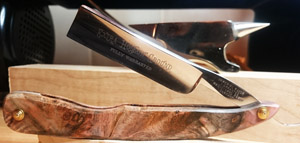Results 1 to 10 of 15
Thread: Stabilizing wood razor scales
-
07-21-2016, 10:36 PM #1Senior Member

- Join Date
- Sep 2015
- Posts
- 695
Thanked: 77 Stabilizing wood razor scales
Stabilizing wood razor scales
I have a pice of spalted oak that I want to make a few sets of scales out of. It's 1/16 inch thick so this may not even be possible but I found a guy who's willing to try to stabilize it. Any tips on working with stabilized wood on straight razors would be appreciated.




Sent from my SAMSUNG-SM-G935A using Tapatalk
-
07-21-2016, 10:46 PM #2

It works really well. I have used two methods for stabilizing spalted maple:
1) runny CA glue: make sure it is the runny stuff, not the usual thick CA. That will just sit on the surface while the runny stuff soaks right in then hardens, working much like any resin, and works *great* with thin stock such as you have
2)cactus juice: which works great especially for thicker stock but is more involved - vacuum chamber, heat curing
It works much like a hardwood in my (limited) experience. One thing to remember is that when you do work it, you're releasing dust from whatever it is you stabilized it with. So take appropriate precautions to avoid breathing the dust.
Give it a shot and let us know how it goes. Good luck!

It was in original condition, faded red, well-worn, but nice.
This was and still is my favorite combination; beautiful, original, and worn.
-Neil Young
-
07-21-2016, 11:29 PM #3Senior Member




- Join Date
- Feb 2013
- Location
- Haida Gwaii, British Columbia, Canada
- Posts
- 14,450
Thanked: 4829
I cannot help with stabilizing but it is very thin so perhaps an alternative would be to epoxy it to a piece of 1/16" G10. G10 is extra super tough stuff and you don't need much for stability.
It's not what you know, it's who you take fishing!
-
07-22-2016, 12:37 AM #4

I wonder if a thin piece of metal as a liner like I see on some custom razors would be helpful for thin stock................
"If You Knew Half of What I Forgot You Would Be An Idiot" - by DoughBoy68
-
07-22-2016, 12:46 AM #5

If you have enough length you could try epoxy two layers of the oak together. That would get you to 1/8, provide some added strength, and you could shape down from there. Maybe end up with a cool grain effect around the edges.
-
07-22-2016, 01:05 AM #6Senior Member

- Join Date
- Sep 2015
- Posts
- 695
Thanked: 77
I have 32 inch so there's plenty of room to play around. I'll experiment more as I get curious
Sent from my SAMSUNG-SM-G935A using Tapatalk
-
07-22-2016, 01:11 AM #7

Making scales for the Joseph Rodgers you recently showed in a different thread? This oak would be nice with it!
-
07-22-2016, 01:59 AM #8Senior Member

- Join Date
- Sep 2015
- Posts
- 695
Thanked: 77
I have the original scales for the Joseph Rogers. I'm thinking about putting these on a Wade and butcher 7/8 once I finish it.

Sent from my SAMSUNG-SM-G935A using Tapatalk
-
The Following User Says Thank You to aaron1234 For This Useful Post:
xiaotuzi (07-22-2016)
-
07-22-2016, 09:09 AM #9Senior Member

- Join Date
- Aug 2015
- Posts
- 317
Thanked: 15
Some of the custom fly rod guys stabalized all sorts of things to make reel seats. Apparently it machines much like plastic when done. They were using CA in a vaccum. This makes me wonder if the wooden boat resoring epoxy would be good too. It's supposed to pennetrate wood well. They used a glass pickle jar and vaccum pump untill the bubbles stopped with lots of warnings about pickle jars in vaccum exploding. They stabalized birch bark. If you can make a reel seat out of that you've done something.
Sent from my SCH-I435 using Tapatalk
-
07-22-2016, 01:15 PM #10

I think that that will be too thin for scales even stabilized but like RezDog stated you could get it stabilized which would make it more sturdy then use a thin liner like G10 to stiffen them a bit more.
As far as stabilization and depending on the method the person uses but most are immersed in acrylic to fill voids and then pressurized for a time to really settle into those cracks and crevices and voids then allowed to harden.
I have worked with stabilized for some time now and in doing so, I like the end product. My latest was a set of scales from buckeye burl that was stabilized to give a German razor a facelift from the plain and mundane black bakelite scales. Here is the final product with brass bullseye stepdown washers and brass pins as well as nylon internal friction washers and ivory acrylic wedge.
 German blade snob!
German blade snob!


 27Likes
27Likes LinkBack URL
LinkBack URL About LinkBacks
About LinkBacks






 Reply With Quote
Reply With Quote




